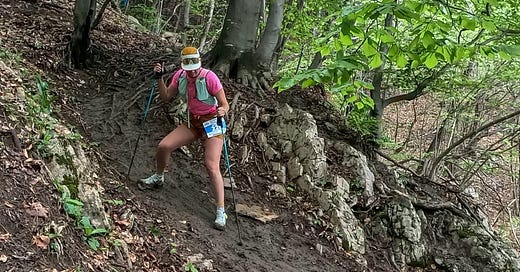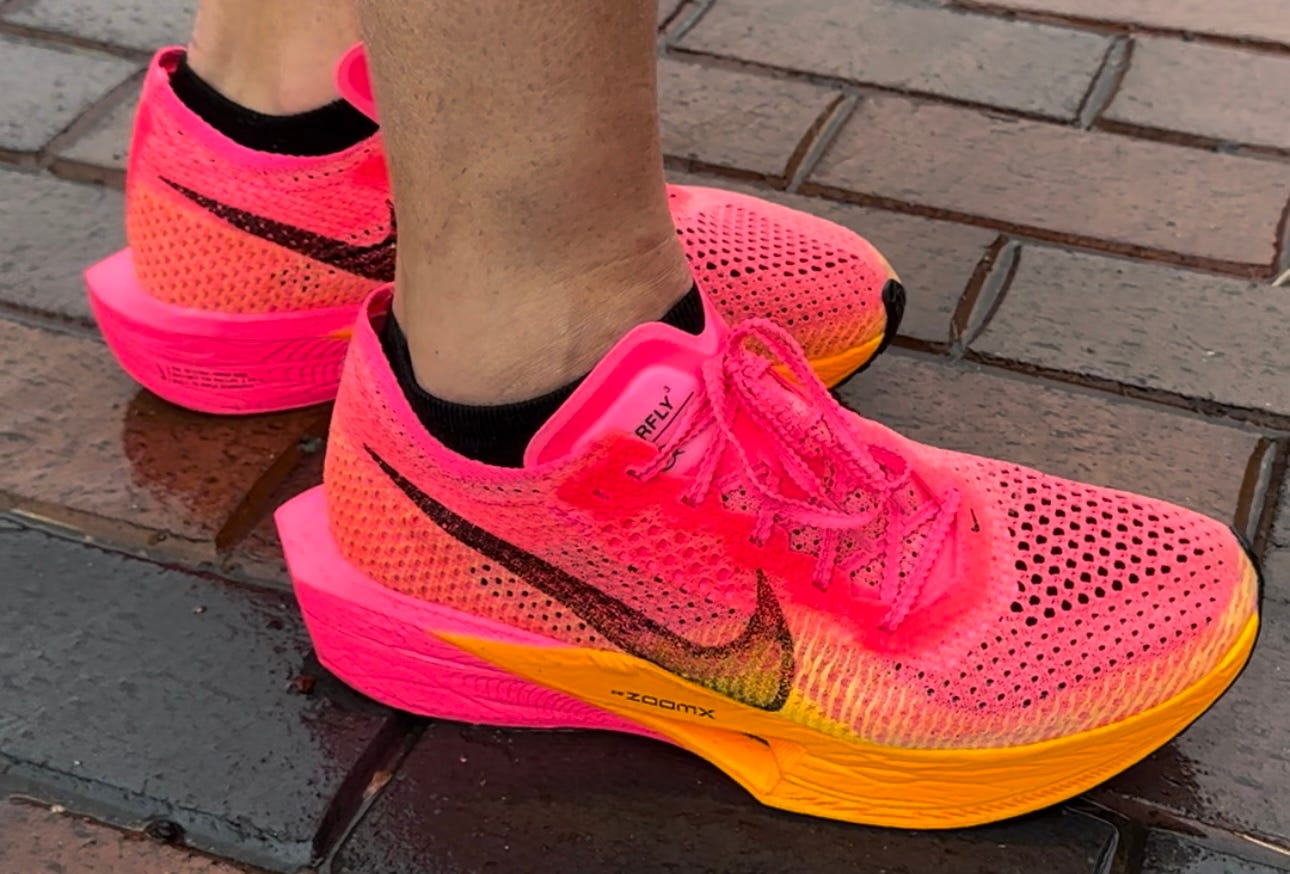Let’s get this out of the way right off the bat: I don’t consider myself a trail runner. Sure, I occasionally run trails. But the furthest I’ve ever gone in a single trail run is 12 miles, and I generally try to avoid running routes with any kind of significant elevation gain—which is why, living in Colorado, I mostly avoid trails.
But I do like pushing myself out of my comfort zone, and after I checked off my sixth and final World Marathon Major in early March, I decided that *this* would be the summer I finally embraced trail running. So it was perfect timing when, at the end of March, Believe in the Run invited me to represent them in racing the UTLAC 30K from Bellagio to Lecco on Lake Como in Italy. (In addition to the 30K, the race offers a 250K race around Lake Como, which is a level of crazy I can’t wrap my head around).
I said yes without really thinking about it, and then I looked at the course and cursed myself because I actually had no idea whether I could complete 6,000-plus feet of elevation over the course of 18 miles within the cutoff time of eight hours. This was my coach’s response:
Six weeks isn’t a lot of time to prepare for a race distance I’ve never run before on terrain I’m unfamiliar with, even though I had recently run a marathon. Anyone who’s ever run trail miles knows that equating them with road miles is like comparing apples to oranges. But after two 12-plus mile trail runs at altitude, each with 2,000-plus feet of climbing, I was starting to feel a little more confident (and even more so after I convinced my friend Katie, a very experienced trail runner, to come with me for pacing and moral support).
Fast-forward to Sunday: As we took a ferry from Lecco to Bellagio, nervously watching the moody sky for signs of storms (the forecast called for “moderate thunderstorms”), my confidence was starting to plummet as I tried to take in just how high these “pre-Alp” mountains were. There were less than 300 runners registered for the 30K, and it felt like even less, and not a single person seemed even remotely concerned as we very casually gathered at the start line—a total one-eighty from my last race experience in Tokyo. It confirmed my feeling that trail running was pretty casual overall, but then the start gun went off and we were running down the street at a sub-8:00 pace.
Fortunately, that quasi-sprint ended pretty quickly when the crowd bottlenecked at a set of stone steps leading from the village up into the mountains. The stairs turned into a steep dirt single track enclosed in a leafy, humid forest. We went from around 650 feet to 1,800 feet within the first two miles, and my heart rate was skyrocketing not just from the climb but from the stress of so many runners on top of each other. I didn’t know how to get out of this conga line, and I hated that I didn’t feel like I could settle into my own pace; everything was dictated by the pressure coming from so many people around me. I went into this race with zero time goals (except finishing before the cutoff), and right off the bat I found myself alternating between stress over whether I could keep up with everyone and fearing that I was holding people up with my slow pace. I thought trail running was supposed to be chill?!
Finally, things started to space out around the 5K mark (this may be because we missed a trail market and had to backtrack a couple hundred meters after another runner came to rescue us) and I could breathe a little easier. But the course was still going up, up, up; we kept climbing all the way to around mile eight. At some point, we popped out of the forest into a field of wildflowers, which then opened up to stunning views of Lake Como below. With the way the clouds were tangled up with the craggy mountain peaks, I get why they call this kind of race “sky running.” But there was a surprising amount of pavement, too, which my feet welcomed even though it was practically impossible to run most of it given the grade of the incline until we topped out on the first climb.
From there, we had around three miles of downhill before the part of the course that terrified me the most: a 2,500-foot climb over about four miles. This was both better and worse than I expected. The steepness of the climb ended up being way less intense than I had built it up to be in my head, but we were essentially navigating uphill in a mudslide. Thank god for trekking poles, because I was essentially planting them in the muck and hauling myself upwards with every step. That view (and the Coca-Cola waiting at the aid station, #bless) at the top, though—it took whatever breath I had left away.
Because I’m a total trail novice, I thought I’d be able to bomb downhill the last few miles. LOL. The first mile and a half of descent ended up being our slowest miles, because the mud here was so slippery we were using poles and trees to keep ourselves from wiping out. This was the only time I was really scared; there were a few times where I had no idea where to put my feet without totally losing control.
After the worst of that, though (I didn’t eat it!), the trail turned back into mostly dirt single track littered with roots and rocks, which continued to hamper my speed. And at this point, my quads were so tired from constantly braking that I really didn’t trust whether I could keep myself upright while navigating all of the obstacles.
With less than three miles to go, we popped out from the woods onto cobblestone roads—I absolutely hated how this felt on my feet—that eventually turned back into pavement. I can’t even put into words the relief that I felt having solid ground under my feet, but we shaved an average of nine minutes off our final three miles.
The finish line should have felt anticlimactic, given that the field was so spread out at this point and there weren’t exactly crowded of spectators cheering us in, but I couldn’t wipe the smile off my face. Road racing has become so familiar to me that it’s been a while since I felt such a sense of appreciation for and awe in my own body. I went into this race concerned that I wouldn’t be capable of finishing before the cutoff time, and ended up finishing it with almost two hours to spare. (Also, I learned distances are merely suggestions in trail racing; this course was billed as a 30K and it was definitely a 32K route—a fun surprise at the end.)
I left this race with two major takeaways: First, I am 1,000 percent a road runner. I really enjoyed being out there for hours and experiencing the course with my friend, but I’ll take the internal pressure and predictability of road racing over the external pressure of trail racing and all its variables. But more importantly, I came away with a renewed sense of gratitude for the fact that I can do hard things, even when I doubt myself—and that when other people believe in you and show up for you, the least you can do is believe in and show up for yourself.
the rundown
Nike Vaporfly 3
I almost forgot how good it feels to put on a fresh pair of Vaporflys. The third iteration of this race day staple feels pretty similar to the second one, thanks to the ZoomX midsole with a full-length carbon fiber plate. But the midsole shape itself was redesigned to feature a thinner layer of outsole rubber, which allows for a few more millimeters of bouncy foam, while the upper is even more breathable, with a next-to-skin fit that doesn’t gap, rub, or dig in. I just can’t get over how much I love this color combo, either. It’s all just so good!
Using a Resistance Band Pre-Run Can Make You Faster
This isn’t a brand-new study, but I just came across it and wish I did earlier—performing a resistance band squat protocol (AKA four by five repetitions of band-resisted squat jumps) before a workout decreased running time and improved neuromuscular properties in endurance athletes running five by 1 kilometer in a 2019 study published in the Journal of Sports Science and Medicine. I know resistance bands are great for pre-run warmups, but I’ve never thought to combine them with plyometrics to give me workouts a boost. You better believe I’m bringing a resistance band to the track from now on.
Spryng2.0 Compression Wraps
A calf-length version of compression boots like the Normatec 3s or Therabody RecoveryAir Jet Boots, the Spryng 2.0 compression wraps (which come out this week) are more reasonably priced and easier to use on the go. Strap them on, set your session to anywhere between 5 and 60 minutes, and choose your preferred therapy profile (graduated compression or pulsated), then go about your business. They’re surprisingly powerful, delivering up to 250 mmHg of compression (mmHg stands for millimeters of mercury, the unit used for measuring pressure)—I have a pretty high pain tolerance, but leaving these on for too long at the highest intensity left my shins throbbing.
The Cult of Marathon Runners Podcast
This is an older podcast, but if you haven’t listened yet (I found it in my downloads on my flight from Milan to Munich), it’s a funny critique on marathon culture—and, really, running as a whole. I very much relate to the idea that while running is presented as a healthy thing to do—an antidote to stress and anxiety—it’s become something that can actually make your life worse under toxic American productivity culture and through the filter of modern technology. The hosts touch on “cultish” aspects like the fear of depression or whether you can still be a a part of the community if you ever stop running. Obviously, it’s not about running, per se; any person or community can make something toxic. But I do think all runners can benefit from the reminder to be wary of how all-consuming this hobby can be.









